This Wednesday was a perfect fall day for Plum Island, and Dave Weaver and I went out to Plum Island and the Parker River National Wildlife Refuge with an excited group of birders. We started as we often do at the platform on the top of the dunes at parking lot #1, where the ocean was less populated than it was last week. A scattering of Red-throated Loons was a plus, and one White-winged Scoter flew by, one! A number of Northern Gannets were visible well off shore, and a couple of them flew very close to the beach. But the big influx of seabirds that we enjoyed right after the October 27 nor’easter had moved back out to sea. One wonders what mollusks or other prey are more abundant out there, and when and why scoters, loons, and grebes will return to our shores. A trio of Double-crested Cormorants struggled in off the ocean, vaguely headed south.
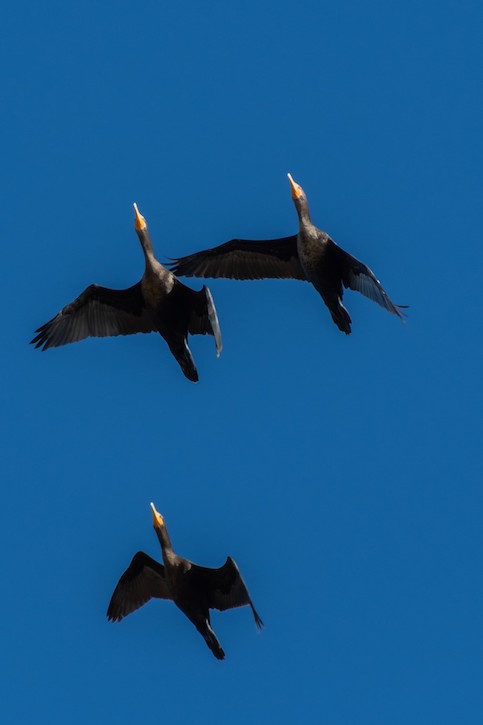
Double Crested Cormorants continue south – Bob Minton
A couple of Semiplamated Plovers hunkered beside debris at the high tide line, late migrants apparently uninterested in foraging in the strong wind. A Peregrine Falcon raised momentary excitement as he (sexed by being somewhat smallish) cruised north along the marsh edge as we returned to the vehicles.
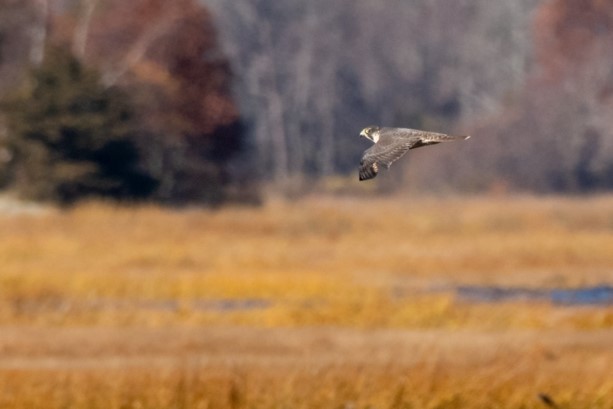
Peregrine Falcon – Bob Minton
As we drove down the refuge road, I noticed a photographer intent on something in the marsh. Craning around briefly, an American Bittern appeared, precipitating everyone out of vehicles to enjoy this beautiful bird at length, as it posed in the salt grass. The photographer told some of us that the bird may have an injured leg, as he saw it hopping in an odd way.

American Bittern in North Marsh – Mike Densmore
Further along, the persistent flock of American Wigeons at the Main Panne slowed us. With shorebirds dashing around, we stopped to enjoy wigeons, Dunlins, and Greater Yellowlegs that dabbled, flew, foraged, and roosted there and in the other salt pannes. A Cooper’s Hawk flew over in classic Accipiter form, flapping and gliding.
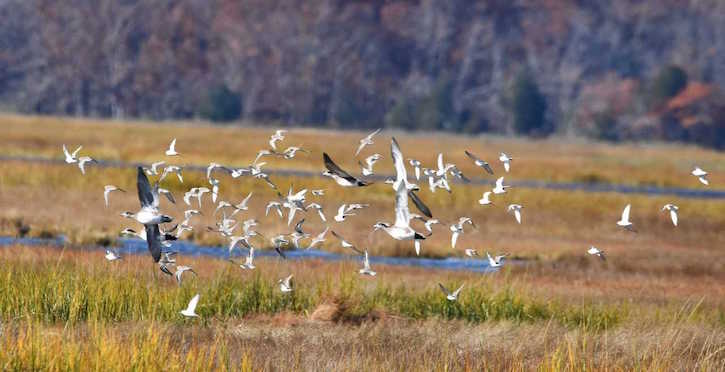
Dunlins and American Wigeons over the Main Panne – Susan Balser
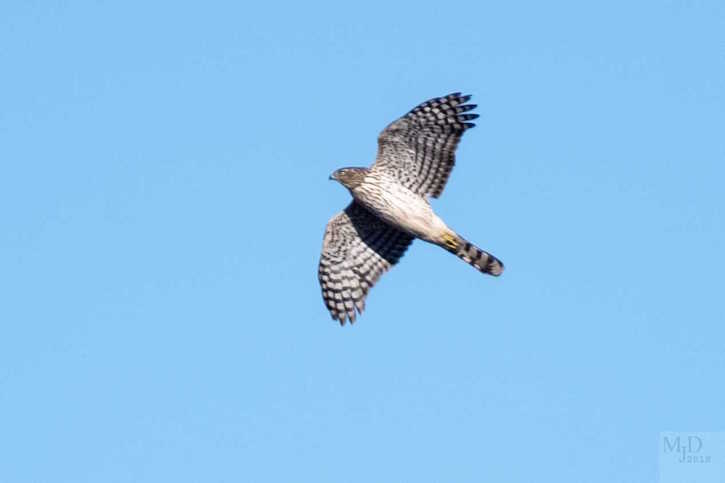
Cooper’s Hawk above Plum Island – Mike Densmore
Hoping for more migratory sparrows, we went to The Warden’s. There were far fewer sparrows this week, but we did find some – a few Chipping, a couple of Clay-colored, a couple of American Tree Sparrows, and one very handsome Savannah Sparrow. Juncos were there, but also less abundant than a week ago, or else the strong wind from the west simply had them hiding in the thickets. A Red-tailed Hawk began kiting off of the updrafts made by the trees at the edge of the marsh. It then flew into the marsh grass, obtained a large vole, and proceeded to put on an extraordinary show very close to us, carrying its prey to various roosts, and eating it graphically while we watched and clicked away. If I included all the fantastic photos of this beautiful bird that people sent, It would be a long show, but here are a few.

Red-tailed Hawk – Bob Minton
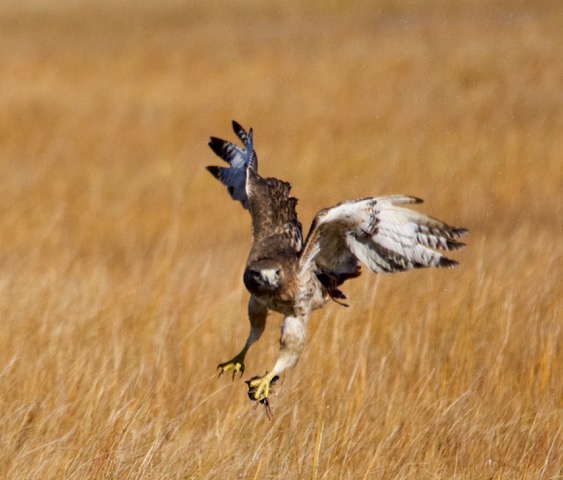
Red-tailed Hawk snatches a meal from the marsh – Barbara Merrill
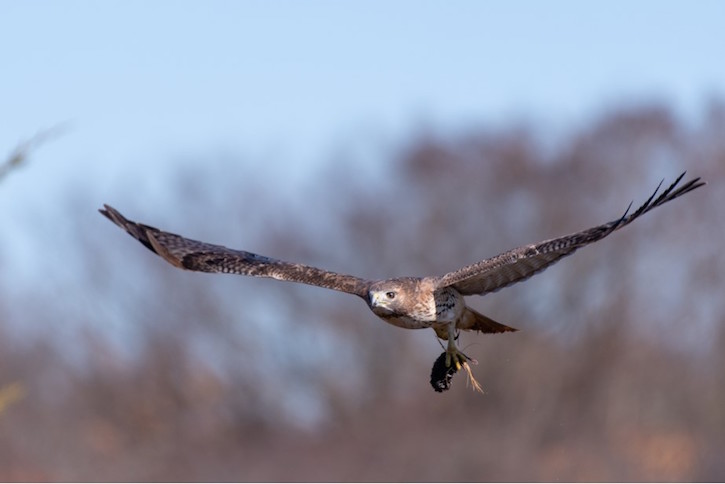
Red-tailed Hawk carries prey – Bob Minton
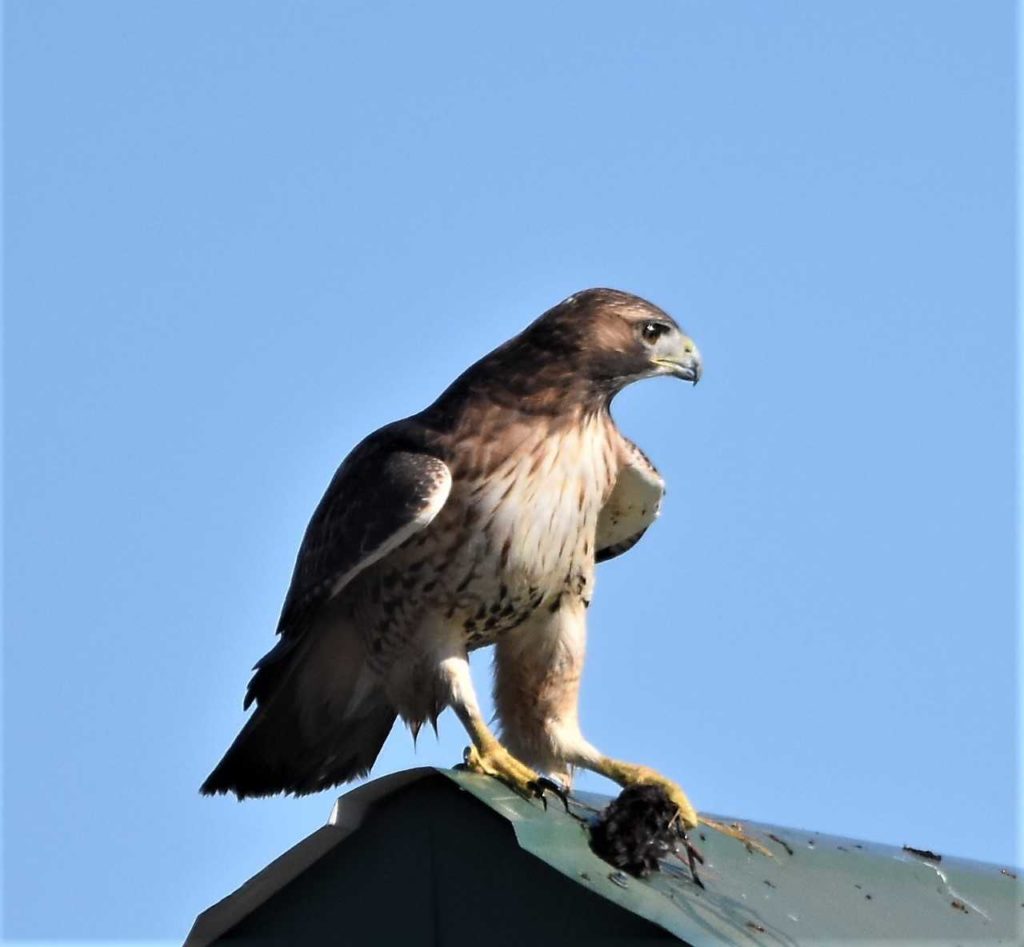
Red-tailed Hawk with vole on slippery perch – Susan Balser
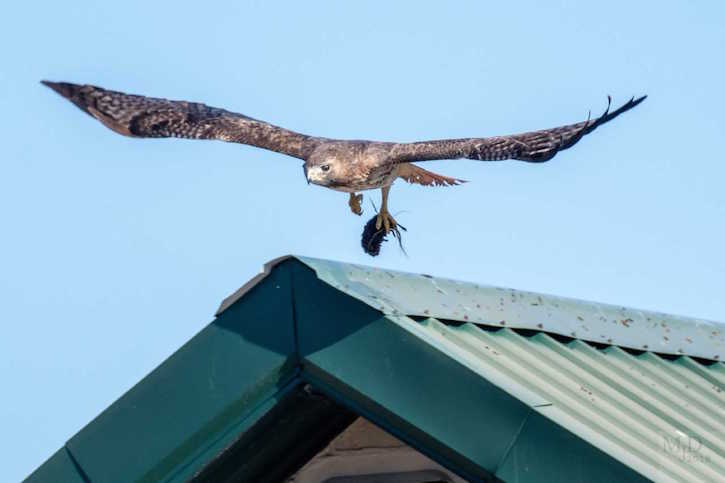
Red-taield Hawk carries prey – Mike Densmore

Red-tailed Hawk, red in claw – Barbara Merrill
After that series of vivid moments with nature, we ran into birders who told us of tremendous avian riches far out on Sandy Point. Deciding that a rare gull is needed once and a while, we drove down to the point, and began the walk all the way to the inner sound. Indeed there were American Pipits in the wrack above the tide line. Hundreds of Dunlins in various flocks and carpets of roosting birds mixed with Black-bellied Plovers.
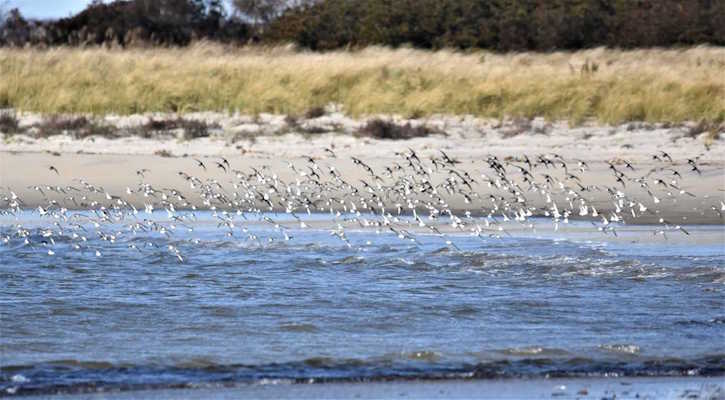
Dunlins by the hundreds – Susan Balser

Semipalmated Plover – Bob Minton
More Semipalmated Plovers stood or sat in the wrack, in a similar way as the ones we had found further north. Two of them were joined by one Semipalmated Sandpiper, a very late migrant. A flock of gulls sat facing into the wind with bills tucked. Scanning through them for a dark bird smaller than the Great Black-backed Gulls, but much darker in the color of the mantle than the Herring Gulls, we spotted a bird who fit the description, and which had an obvious hood of dark speckles, a Lesser Black-backed Gull.
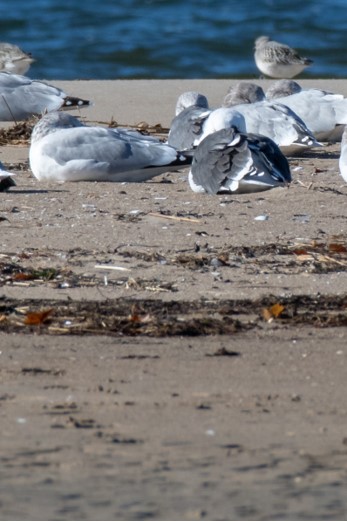
Lesser Black-backed Gull – Bob Minton
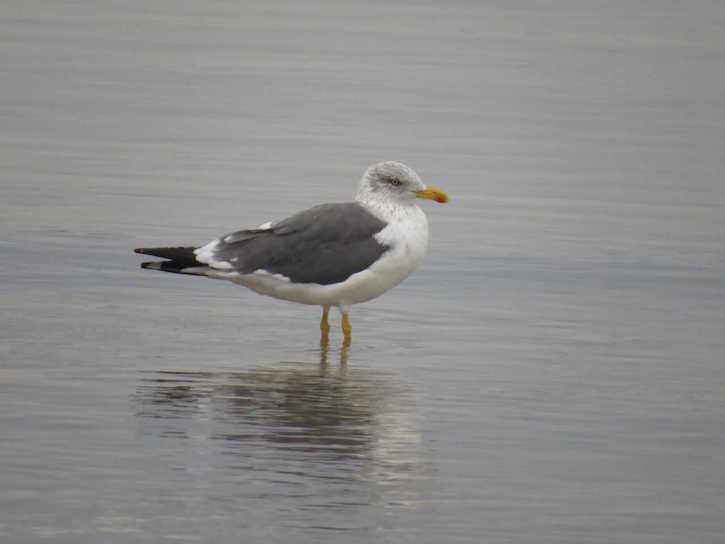
Lesser Black-backed Gull at Sandy Point, recent sighting – Dave Adrien
We would have loved to see the bird’s bright yellow legs, but were confident that we had found the rare gull, confirmed by seeing pictures taken by Dave Adrien of the same bird on a previous occasion as it stood in full view. At that point we were really out of time, and scurried back to Joppa, happy with another joyful time with lots of birds, with each other, and with all of nature among the rich environments we find at the edge of land.
A note on our continued progress in seeing birds on Wednesday Mornings: With the Lesser Black-backed Gull, WMB is 2 birds short of 200 species for the year. Help us find them!
Our list:
Canada Goose (17) – north of The Warden’s.
Mute Swan (3) – 1, marsh west of parking lot #1 (one); 2, Main Panne.
American Wigeon (~ 20) – Main Panne.
American Black Duck – common; various.
Mallard – a few.
White-winged Scoter (1) – one, ocean.
Red-throated Loon (~ 6) – one, ocean.
Northern Gannet (3) – 1st-yr; one ocean
Double-crested Cormorant (~ 53) – 3 juveniles, one ocean; ~ 50, high-flying flock moving south.
American Bittern (1) – marsh between parking lots #1 & #2;
Great Blue Heron (3) – hay marsh.
Northern Harrier (1) – The Warden’s.
Cooper’s Hawk (1) – over main panne.
Red-tailed Hawk (2) – over dunes n. The Warden’s.
Black-bellied Plover (~ 12) – Sandy Point.
Semipalmated Plover (~ 15) – 3, one beach; ~ 12, Sandy Point.
Greater Yellowlegs (~ 15) – ~ 5, pannes; 10, marsh n. The Warden’s.
Sanderling (2) – one beach.
Semipalmated Sandpiper (1) – Sandy Point.
Dunlin (~ 450) – small flock, one beach; balance Sandy Point (thanks, Tim & Dave Adrian!).
Ring-billed Gull (3) – one beach.
Herring Gull – common.
Lesser Black-backed Gull (1) – Sandy Point (thanks, Tim!).
Great Black-backed Gull (~ 10) – various, mostly Sandy Point.
Rock Pigeon
Peregrine Falcon (1-2) – parking lot #1; pannes.
Blue Jay (1)
American Crow (2)
Northern Mockingbird (2) – 1, parking lot #1; 1, The Warden’s.
European Starling – multiple large flocks.
American Pipit (11) – Sandy Point.
Yellow-rumped Warbler (5) – The Warden’s.
American Tree Sparrow (2) – The Warden’s.
Chipping Sparrow (4) – The Warden’s.
Clay-colored Sparrow (2) – The Warden’s.
Savannah Sparrow (1) – The Warden’s.
Song Sparrow (2) – The Warden’s.
Dark-eyed Junco (5) – The Warden’s.
House Finch (3) – Sandy Point.
American Goldfinch (2) – The Warden’s.


Also on Wednesday, though not with your group, two of us saw Greater Black-Backed Gull 5T9 hanging out at Sandy Point (from the federal, not state parking area). A little embarrassed that we didn’t note the band at the time, though it’s very obvious in photos I took. We reported the sighting, and read with interest more about the Appledore gull banding study (e.g. https://gullsofappledore.wordpress.com/about/). Sounds like 5T9 is well known from Sandy Point in winter.
Thanks, Sara –
For years there has been a Glaucous Gull that winters in Seabrook, roosting during most every high tide on the cupola of the restroom building in the parking lot that overlooks the harbor at the north end of the island. Such regularity appears in individuals of other uncommon bird species to some extent, such as the persistence of a Barrow’s Goldeneye in Saco Maine, and a King Eider in Rockport. They aren’t always in the exact same spot, but appear to have a high degree of site fidelity in their wintering behavior. All this indicates that our impression that birds we see every day may be different ones instead of the same ones could be off base. We know that breeding passerines return to the same patch of woods every year if they can, and a huge banding project, MAPS, relies on that to learn whether migratory birds are declining more in breeding areas or through lower survivorship in non-breeding times. If most birds know where they are and survive better by following successful routines, it makes sense that the same birds go to the same places year after year, as long as they find food or avoid hazards. Its pretty cool, no? We only tend to perceive this with a rare one or one with a band, but many if not most of our neighborhood birds are likely to really be our neighbors, even if only for a season. Many of them may well know us as individuals better than we know them! There is so much to learn.